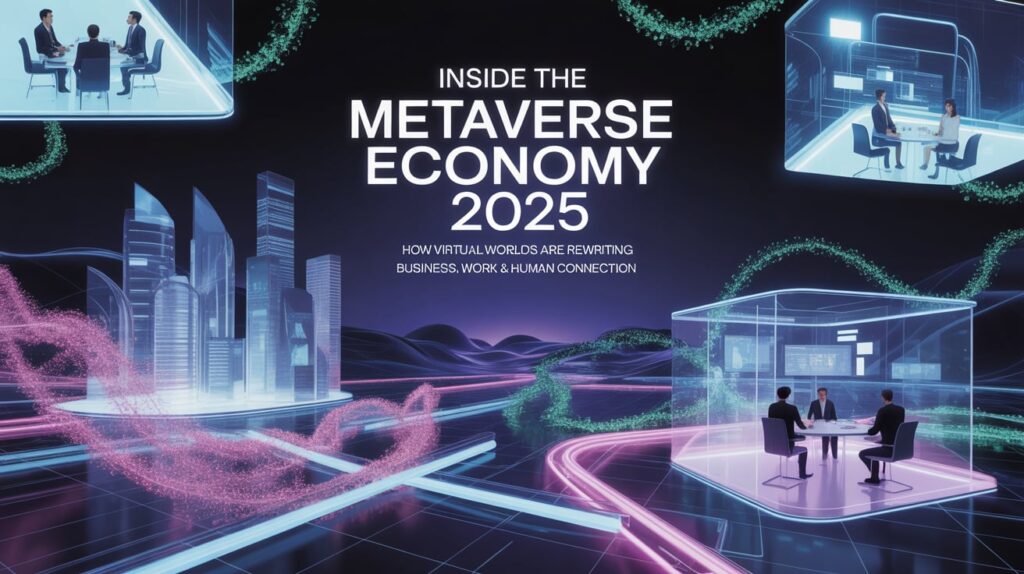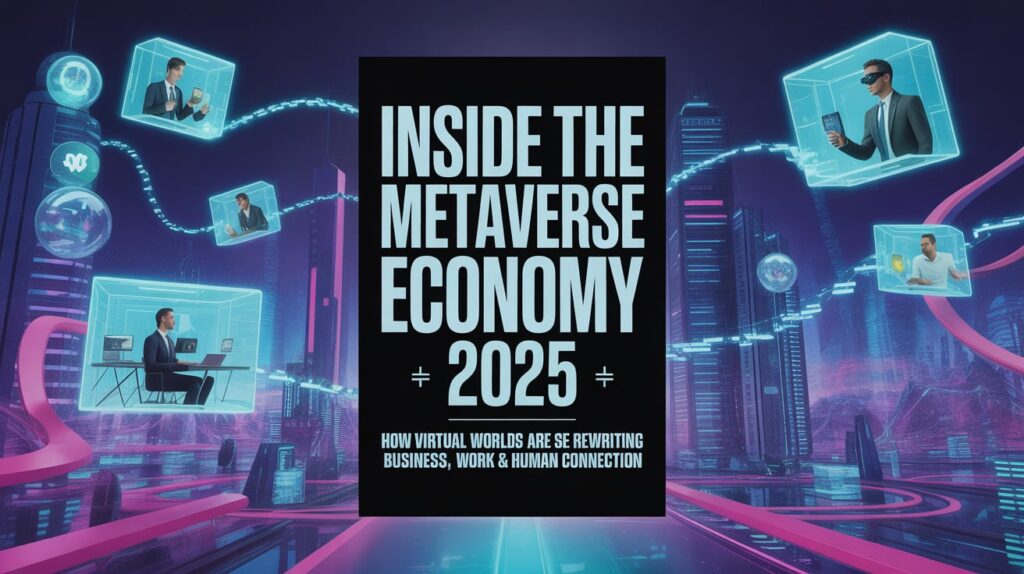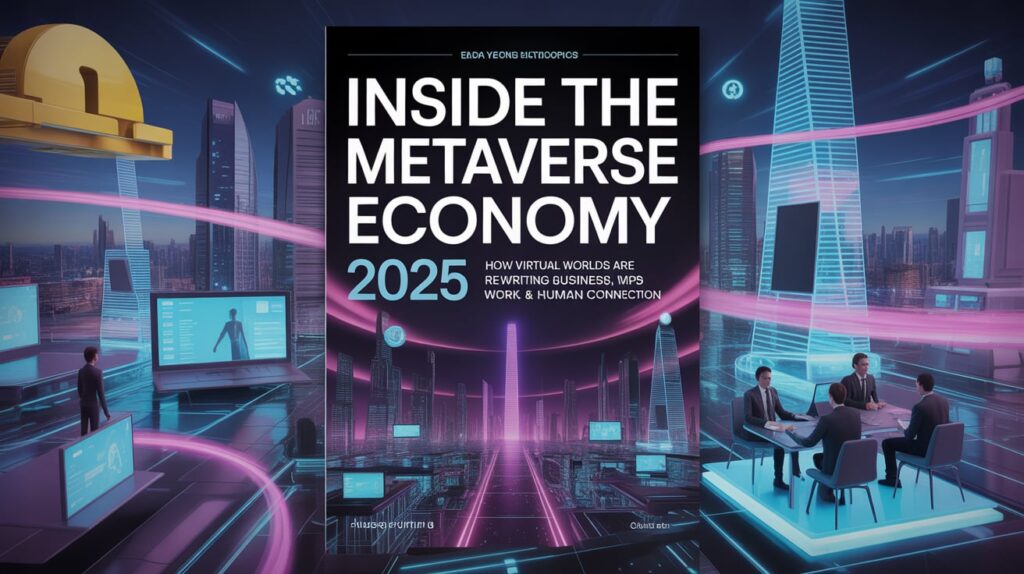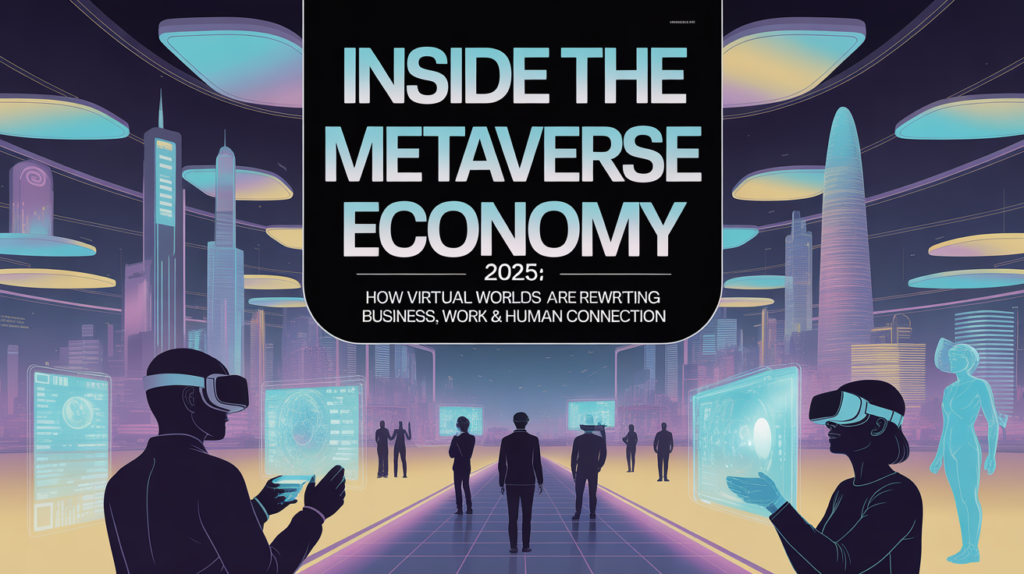Inside the Metaverse Economy 2025: How Virtual Worlds Are Rewriting Business, Work & Human Connection

The Metaverse Economy: The Future That’s Already Here
The Metaverse economy isn’t just a buzzword anymore — it’s becoming a functioning digital ecosystem where real money changes hands, real work gets done, and real communities are built.
By 2025, the lines between the physical and digital worlds have blurred beyond recognition. Millions of people now socialize, trade, learn, and earn in virtual environments powered by blockchain, extended reality (XR), and artificial intelligence.
From corporate boardrooms to indie creators, everyone is finding their place inside this new digital universe. But to understand how we got here — and where we’re headed — we need to trace the evolution of the Metaverse economy, its opportunities, challenges, and the monumental impact it’s having on global industries.
Chapter 1: The Birth of a Digital Universe
1.1. From Sci-Fi to Reality
The term “Metaverse” originated decades ago in science fiction, but the dream started taking shape in the late 2010s when gaming, crypto, and social media began to merge.
Fast forward to the mid-2020s, and what once sounded futuristic — walking through a digital city, buying property with tokens, or attending a virtual concert — is now mainstream.
Companies like Meta, Nvidia, Microsoft, and countless Web3 startups invested billions in virtual infrastructure. Meanwhile, blockchain technology made digital ownership possible, creating a foundation for an economy built on trustless transactions and verifiable assets.
1.2. The Role of Blockchain and NFTs
The blockchain became the beating heart of this digital universe. NFTs (non-fungible tokens) proved that you could own a virtual item — a piece of art, a plot of land, or even a digital identity — in a way that was secure and verifiable.
By 2025, NFT-based real estate, wearables, and intellectual property rights are the backbone of digital commerce. Virtual property moguls are a thing. Fashion houses release exclusive digital collections. Artists host exhibitions in immersive VR galleries.
What began as speculation has matured into a creator-driven economy where innovation meets decentralization.
Chapter 2: Building the Metaverse Economy
2.1. The Infrastructure: Who’s Powering It?
Behind the scenes, several technologies converge to make the Metaverse work:
-
5G and 6G networks enabling seamless real-time experiences
-
Cloud computing supporting persistent virtual worlds
-
AI avatars acting as assistants, tutors, or companions
-
Decentralized finance (DeFi) managing transactions, lending, and insurance
-
Virtual reality (VR) and augmented reality (AR) bridging physical and digital spaces
Tech giants like Meta (formerly Facebook), Apple, and Nvidia continue to dominate the infrastructure layer, while decentralized platforms such as Decentraland, The Sandbox, and Spatial fuel the user-owned side of the economy.
2.2. Digital Currencies and Tokenized Assets
At the core of the Metaverse economy lies digital money. Cryptocurrencies and stablecoins are the native currencies of virtual worlds.
Every interaction — from buying a coffee in a VR café to paying for virtual land development — runs on blockchain rails.
Even major banks have entered the arena. By 2025, several financial institutions have established “Metaverse branches”, allowing customers to walk into a virtual lobby, talk to an AI banker, and execute real-world transactions — all from their headsets or browsers.
Chapter 3: How Businesses Are Thriving in the Metaverse

3.1. Virtual Retail and Digital Commerce
The Metaverse is the new shopping mall. Brands like Nike, Gucci, and Adidas now sell virtual fashion with NFT authentication. Consumers can buy a pair of sneakers for their avatar that also unlocks a real-world version delivered to their home.
This integration of phygital commerce (physical + digital) has created trillion-dollar opportunities. Virtual storefronts are cheaper to maintain and can reach a global audience instantly.
3.2. Marketing in 3D Worlds
Forget banner ads. In 2025, marketing happens through experience. Brands create quests, host concerts, or sponsor esports tournaments to build engagement.
User participation drives virality — not passive scrolling.
Companies are hiring “Metaverse strategists” who understand virtual behavior, token incentives, and digital storytelling.
3.3. Real Estate Boom 2.0
Remember when people laughed at digital land sales? Now, the joke’s on the skeptics. Virtual plots in top metaverse platforms are trading like high-end real estate. Developers build VR skyscrapers, digital offices, and interactive entertainment zones, all monetized through NFT ownership.
Investors are even forming Metaverse REITs (Real Estate Investment Trusts) to manage portfolios of virtual properties.
Chapter 4: The Future of Work and Education
4.1. Work Without Borders
The Metaverse has redefined remote work. Instead of Zoom calls, teams meet in 3D digital offices. Avatars sit across from each other at holographic tables.
Meetings feel natural, interactive, and immersive.
Some companies have completely moved into virtual campuses, where onboarding, brainstorming, and team-building occur in shared VR spaces.
4.2. Freelancers and the Creator Revolution
A new generation of workers thrives purely inside the Metaverse. 3D designers, virtual architects, digital fashion creators, and world-builders earn crypto directly for their skills.
Freelancers can create an entire career inside virtual ecosystems — building homes, coding worlds, or designing branded experiences.
4.3. Learning in the Metaverse
Education has been transformed. Virtual classrooms are immersive, allowing students to walk through historical sites, explore molecular biology in 3D, or attend lectures by AI professors.
Institutions like Harvard and MIT now offer “Metaverse degrees”, combining gamified learning with real-world credentials.
Chapter 5: The Human Side of the Metaverse
5.1. Identity and Digital Citizenship
Your avatar is more than just pixels — it’s an extension of your personality and brand. In 2025, individuals manage decentralized digital IDs, controlling how much data they share and how they appear across virtual worlds.
Identity ownership empowers users, reducing dependence on big tech while enabling freedom of expression and mobility.
5.2. Community and Social Connection
Contrary to fears that the Metaverse would isolate people, many find a stronger sense of belonging there. Virtual communities are formed around interests, not geography.
From mental health support groups to cultural festivals, people connect across borders in meaningful ways.
5.3. The Psychology of Presence
Studies show that humans experience genuine emotional reactions in virtual environments. The concept of “presence” — feeling truly there — creates deeper empathy and engagement.
Therapists now use VR sessions for anxiety, PTSD, and phobia treatments, blending mental health and digital immersion.
Chapter 6: Economic Impact & Market Projections
By 2025, the global Metaverse economy is projected to exceed $1.2 trillion in annual value, according to industry analysts.
6.1. Key Growth Drivers
-
Explosion in VR headset adoption
-
Integration of blockchain-based commerce
-
Rise of the creator economy
-
Expansion of virtual workspaces
-
Institutional investment in digital assets
6.2. Major Sectors Benefiting
-
Gaming and Entertainment — interactive concerts, digital cinemas, and esports
-
Fashion and Retail — virtual try-ons and NFT collectibles
-
Real Estate and Architecture — virtual property development
-
Finance — crypto banking and metaverse-based DeFi
-
Healthcare — VR therapy and telepresence medicine
-
Education and Training — immersive learning simulations
6.3. Risks and Volatility
However, like any emerging economy, volatility exists. Asset bubbles, speculative land grabs, and regulatory uncertainty can slow adoption.
Cybersecurity and privacy also remain major concerns.
Chapter 7: Challenges Facing the Metaverse Economy

7.1. Regulation and Governance
Who governs the Metaverse?
With multiple platforms owned by different entities, governance remains fragmented. Some call for DAO-based (Decentralized Autonomous Organization) systems where users collectively vote on policies.
Governments are also entering the conversation, balancing innovation with consumer protection.
7.2. Data Privacy and Security
The Metaverse collects immense biometric and behavioral data. Misuse or exploitation could become a new frontier of cybercrime.
Ethical data handling and user consent are paramount.
7.3. Inequality and Accessibility
A high-end VR headset and fast internet connection are still luxuries. Without inclusive access, the Metaverse risks replicating real-world inequalities.
Platforms are now developing low-bandwidth modes and mobile-friendly access to bridge the gap.
Chapter 8: The Next Decade — Where We’re Headed
8.1. The Rise of AI Companions
In the coming years, AI avatars will become increasingly lifelike — remembering conversations, adapting personalities, and providing companionship or collaboration.
The line between “bot” and “friend” will blur, raising philosophical questions about identity and empathy.
8.2. Interoperability — The True Metaverse Dream
For the Metaverse economy to thrive, platforms must connect seamlessly. Imagine taking your avatar, wallet, and digital assets from one world to another without friction.
That’s the next frontier — the Open Metaverse, powered by universal standards.
8.3. Sustainability and Real-World Impact
The infrastructure behind virtual worlds consumes energy. Developers are adopting green blockchains, carbon-neutral data centers, and AI optimization to build sustainable ecosystems.
If successful, the Metaverse could reduce real-world travel emissions by replacing physical commuting and events with virtual equivalents.
Chapter 9: Opportunities for Investors and Entrepreneurs

9.1. Emerging Startups
Thousands of startups are entering this space — from virtual event hosting to AI-driven avatar creation. Venture capital investment in Metaverse projects topped $120 billion in 2025 alone.
9.2. Areas to Watch
-
Metaverse architecture and world-building
-
Virtual goods marketplaces
-
Education tech (Ed-Metaverse)
-
Healthcare applications
-
Blockchain gaming and play-to-earn economies
9.3. How to Participate
Even small investors can participate by buying tokens, digital land, or investing in Metaverse-focused ETFs. However, caution and research remain essential.
Chapter 10: The Human Story — Why It Matters
At its core, the Metaverse economy isn’t about technology. It’s about possibility. It’s the next chapter in humanity’s story — where creativity, connection, and commerce merge.
People once built civilizations along rivers and coastlines. Now, they’re building them in pixels and code.
The Metaverse will not replace the real world — it will enhance it. It’s a digital mirror reflecting who we are, what we value, and how we collaborate.
As we step deeper into this era, one truth becomes clear:
The Metaverse isn’t the end of reality — it’s the expansion of it.
Conclusion: Living, Working, and Thriving in the Metaverse
The Metaverse economy represents a seismic shift — from centralized control to user empowerment, from passive consumption to active participation.
It’s the new digital frontier where imagination becomes capital, creativity becomes currency, and community becomes the core of everything.
The question is no longer “Will the Metaverse succeed?” but “How fast will we adapt?”